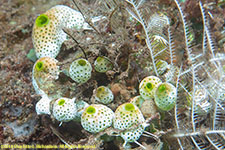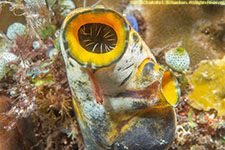 Robust seq squirt, Ariolum robustum
Robust seq squirt, Ariolum robustumTunicates are urochordates. They do not have backbones, but at some point in their life cycle they have a tail, a central nerve cord, a phyaryngeal gill cleft, and a notochord. Tunicates have a body covering of celluluse, the tunic. They attach to the substrate and have two siphon openings.Water is drawn in one siphon, pumped through a gill net in the body where food and oxygen are extracted, and then discharged through an excurrent siphon. When the animals is distrubed it closes the siphons. Most large tunicates are solitary. Many smaller species are colonial. In some colonial species individuals are embedded in a common tunic. Some compound colonial species have a merged excurrent siphon and individual incurrent siphons.
 Robust seq squirt, Ariolum robustum
Robust seq squirt, Ariolum robustum
 Gold-mouth sea squirt, Polycarpa aurata
Gold-mouth sea squirt, Polycarpa aurata
©2019, 2024 Mermaid Underwater Photographic. All Rights Reserved.
Contact us at mermaid@underwater.org.
Last modified 30 October 2024